Being hacked is a stressful situation for any website owner. The first step in fixing your website is to act quickly. Knowing what to do next is crucial.
We will guide you through the steps to recover from a hack. This will help you protect your site from future attacks. It’s important to learn how to handle these situations to keep your online presence safe.
Understanding Website Hacking
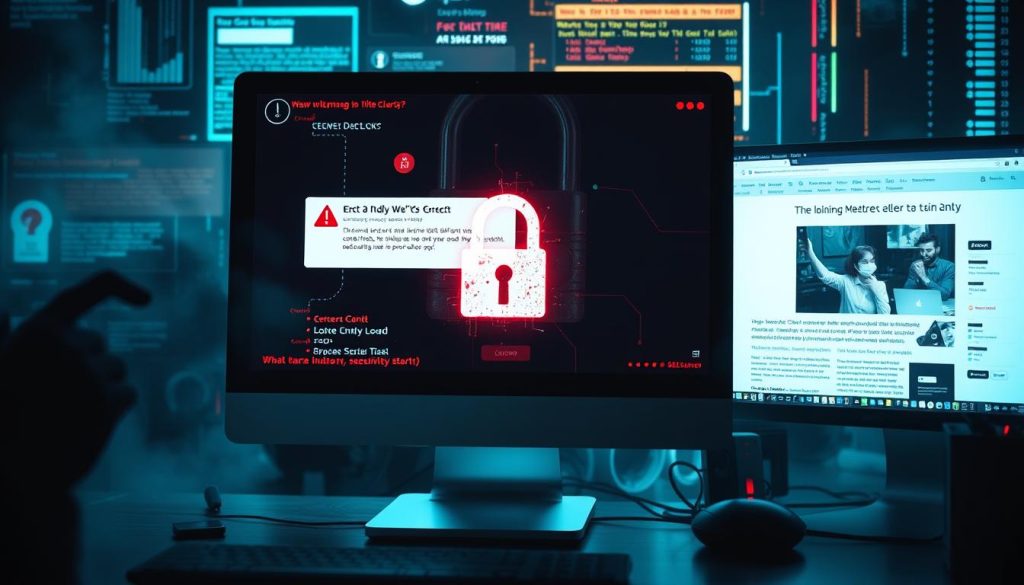
Website hacking is a big threat to online safety. It includes many tactics used by bad actors. It’s key to spot signs of a hacked site quickly. Look out for sudden changes, like different content or unknown users accessing your site.
Also, if your site starts to slow down, it might be hacked. This is a warning sign.
Common Indicators of a Hacked Website
Spotting a hacked site early is vital. Here are some common signs:
- Unexpected behaviour, like pages going to strange sites.
- New users or admins you didn’t add.
- Changes to your site’s content that you didn’t make.
- Big changes in traffic or site speed.
- Malicious scripts or code showing up on your site.
Types of Website Hacks
There are many ways a site can get hacked. Knowing about these helps keep your site safe. Here are some common types:
- SQL Injection: Hackers get into your database, risking your data.
- Cross-Site Scripting (XSS): They inject scripts to steal info or spread malware.
- Distributed Denial of Service (DDoS): They flood your site with traffic, making it crash.
- Brute Force Attacks: They try lots of passwords to get in, often targeting weak ones.
Immediate Steps to Take Post-Hack

After a hacking incident, acting fast is key. The steps you take first can greatly affect how well you recover. Knowing how to check for damage, talk to your hosting provider, and document the hack is crucial. It helps protect your website from future threats.
Assessing the Damage
The first thing to do is to check how bad the hack is. Look for signs like:
- Defaced webpages or changed content
- Unusual user activity or access logs
- Suspicious files or scripts in your website’s directory
- Theft of sensitive information, like customer details
This check tells you how serious the problem is. It guides you on what steps to take next.
Contacting Your Hosting Provider
Talking to your hosting provider is very important after a hack. They can help a lot with security issues. They can:
- Look at server logs to find where the hack came from
- Put in place security steps to stop more damage
- Help you fix your site
Acting quickly can help keep your site safe from more harm.
Documenting the Incident
It’s important to keep a record of the hack. This helps you understand the impact and might be needed for legal reasons. Note things like:
- Date and time of the breach
- What kind of attack it was and where it hit
- What you did to fix the problem
- Talks with your hosting provider and others
This record helps with future safety and is a guide for your security efforts.
What if my website has already been hacked?

Discovering a hacked website is alarming. But, acting quickly is key to limit damage. Immediate action can protect your site and start the recovery process. This part will cover the first steps to take and why checking your security is vital.
Initial Response Strategies
When you find out your website has been hacked, you must act fast. The first thing is to isolate the affected system to stop malware spread. Here are some steps to consider:
- Disconnect the website from your hosting server temporarily.
- Change all passwords for your site, like database, admin, and FTP.
- Talk to your hosting provider for emergency help.
- Inform users if their personal data might have been leaked.
Evaluating Your Security Configuration
After discovering the hack, a detailed security check is needed. This will show you any weak spots in your site’s security. Knowing these areas will help strengthen your defences:
- Look at access logs for any odd activity.
- Check if your firewalls and security plugins are working well.
- Make sure file permissions are set right.
- Update all software, like CMS, plugins, and themes, to the latest versions.
How to Remove Malware from Your Website

It’s vital to remove malware from your website to keep it safe and secure. You can use security plugins or try manual methods if you’re more tech-savvy.
Using Security Plugins
Security plugins are a simple way to find and remove malware. For example, Wordfence scans for weaknesses, blocks bad traffic, and protects with a firewall. Here’s how to use them:
- First, install the security plugin on your site.
- Then, run a full scan to find malware and weaknesses.
- Follow the plugin’s advice to get rid of the threats.
- Finally, set up regular scans to keep your site safe.
Manual Malware Removal
If you’re good with tech, you can manually remove malware. This method involves:
- Logging into your website’s file manager through your hosting panel.
- Looking for and deleting any odd files or code in your site’s folders.
- Checking core files for any unwanted changes or scripts.
- Using clean backups if malware has really damaged your site.
Restoring Your Website
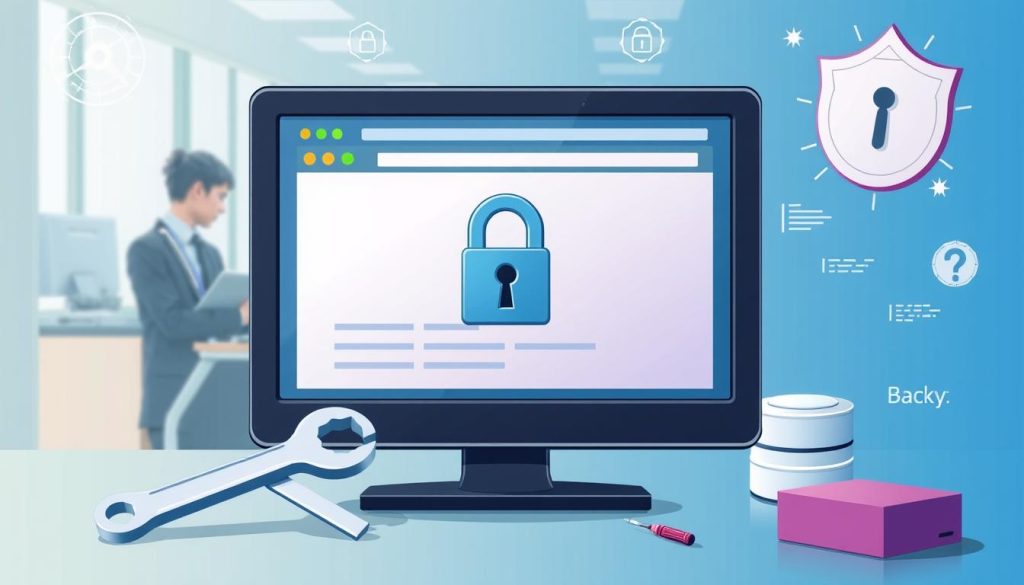
After removing malware, restoring your website is key. This step uses backups to get your site back up and running. It aims to reduce downtime and get everything working smoothly again. Planning well here can greatly improve your recovery.
Utilising Backups for Recovery
Backups are vital after a hack. Make sure the backups you use are recent and clean. Here’s how to recover your site effectively:
- Access your backup storage solution.
- Select the most recent clean backup, ensuring it has no signs of compromise.
- Restore the website files and database from the chosen backup.
- After restoration, check all key functionalities, including forms, e-commerce, and multimedia elements.
Steps to Take After Restoration
Restoring your site is just the start. A detailed checklist after restoration can strengthen your site’s security. Here are some steps to follow:
- Verify that all components of the website are functioning correctly.
- Conduct a security audit to assess vulnerabilities.
- Update all software, plugins, and themes to the latest versions.
- Change passwords for all accounts related to the website.
- Implement monitoring tools to track unusual activities.
By following these steps, you ensure a strong recovery and protect your site from future threats.
Strengthening Website Security
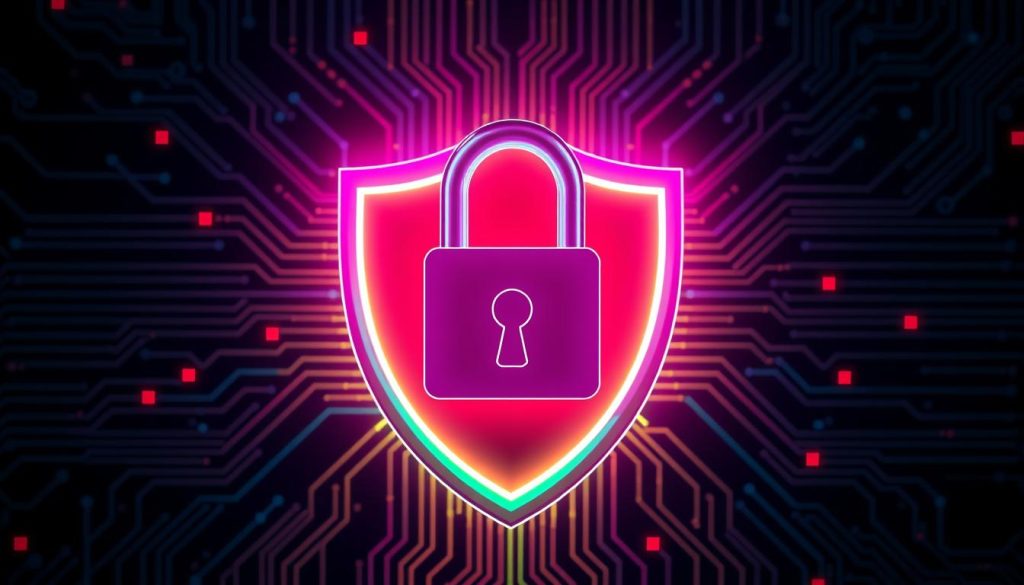
Businesses need to take steps to stop hackers. They should focus on strong passwords, keep software up to date, and use SSL for websites. These actions can greatly improve online safety.
Implementing Strong Password Policies
Creating strong password rules is key to protecting your site. Passwords should be:
- Complex, with letters, numbers, and special characters.
- Changed often to prevent hackers.
- Not based on common words or personal info.
Teaching staff about good password habits is also important.
Regular Software Updates
It’s crucial to keep all software current. This includes:
- The main platform, like WordPress or Joomla.
- Themes and plugins on your site.
- Security updates from providers.
By updating regularly, you lower the risk of hackers finding weak spots.
Employing SSL Certificates
SSL certificates encrypt data between users and your server. This keeps sensitive info safe and makes visitors trust your site. Using an SSL certificate can:
- Keep user data safe from hackers.
- Help your site rank better in search engines.
- Make your site more trustworthy.
Monitoring for Future Threats
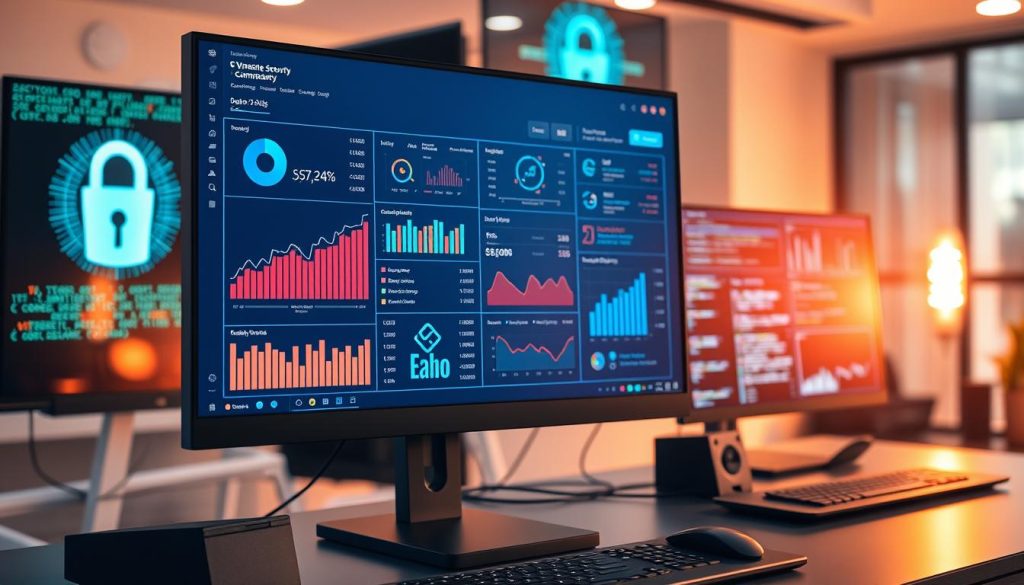
Keeping your website safe means always being on guard. Regular security checks are key to spotting weak spots and making your site safer. These steps help stop small issues from becoming big problems.
Setting Up Regular Security Audits
Regular security audits are crucial to fight off future attacks. These audits should cover:
- Checking user permissions and access logs
- Testing for code and plugin vulnerabilities
- Keeping all software up to date and set up right
By doing these, you can handle your website’s security better.
Utilising Monitoring Tools
Website monitoring tools are vital for good security. Tools like Google Search Console and Sucuri send alerts for odd activity. They help you act fast to stop breaches, keeping your site safe.
Educating Yourself on Cyber Threats

In the fast-changing world of cybersecurity, learning never stops. Knowing common security risks and keeping up with trends helps protect your online world. This education helps website owners make smart choices to keep their digital spaces safe.
Common Security Vulnerabilities
Website security has many challenges. Spotting common risks is key to managing risks well. Important areas to watch include:
- Outdated software that lacks essential updates
- Weak configurations that fail to follow security best practices
- Unsecured user credentials and weak password policies
- Ineffective access controls that leave sensitive data exposed
Keeping Up with Security Trends
Staying ahead in security is crucial. Knowing the latest threats helps you act fast. Some trends to watch include:
- Increased focus on data privacy and compliance regulations
- Growing prevalence of ransomware attacks targeting businesses
- Integration of advanced AI-driven security solutions
- Emphasis on user education and awareness to combat phishing attacks
Engaging with Cybersecurity Professionals

Hiring cybersecurity experts is key for businesses to tackle modern cyber threats. Knowing when to get a professional’s help is vital for strong security. In cases of data breaches or ongoing threats, expert advice is needed for full protection.
When to Hire an Expert
There are times when you really need cybersecurity pros. Here are some examples:
- After a data breach that needs a deep look.
- When dealing with constant security issues or odd network actions.
- Before a big website update or redesign.
- To check if your security meets the rules.
What to Look for in a Security Consultant
Finding the right security consultant is important for your website’s safety. Here’s what to look for:
- Make sure they have the right qualifications and certifications.
- Look for someone with lots of experience in cybersecurity, especially with businesses like yours.
- Check what past clients say about their work.
- They should keep up with new trends and tech.
Legal and Compliance Considerations
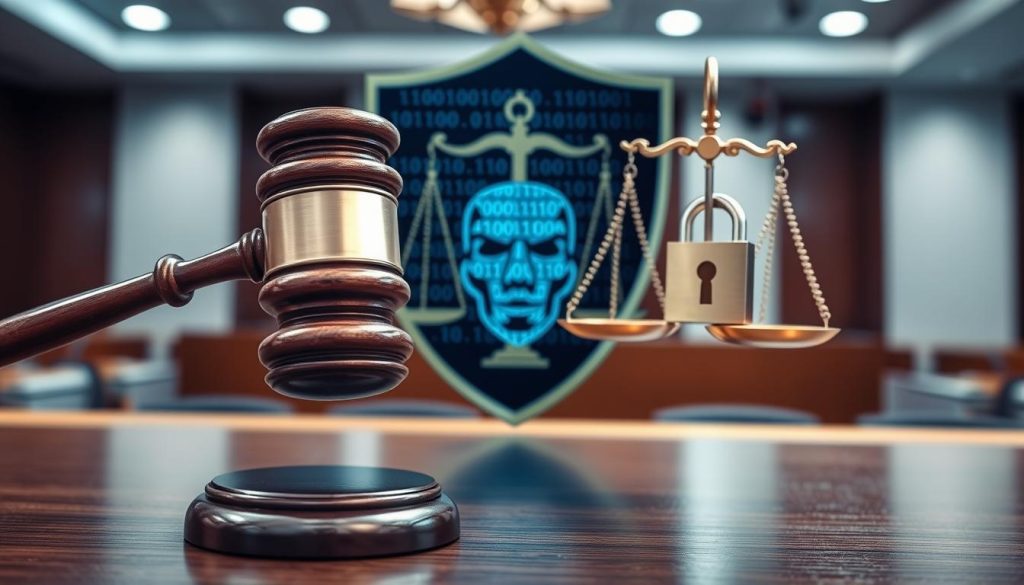
After a hacking incident, knowing the legal side of hacking is key for businesses. Following rules like the General Data Protection Regulation (GDPR) is vital. It helps keep personal data safe and avoids legal trouble. Understanding GDPR well, especially when data is leaked, is crucial.
Understanding GDPR Implications
The GDPR makes data handling clear and fair. If a data breach happens, companies must check their GDPR duties. Not following GDPR can lead to big fines. Important points include:
- Checking the data lost to see how serious the breach is.
- Finding out how the breach might affect people.
- Keeping records of the breach and how it was fixed.
Notifying Affected Users
Telling users about a breach is also key. GDPR says companies must tell people quickly if their data is at risk. The notice should include:
- A clear explanation of the breach and its risks.
- What steps were taken to fix the problem and protect data.
- Advice on what users can do to protect themselves.
Using a Web Application Firewall (WAF)
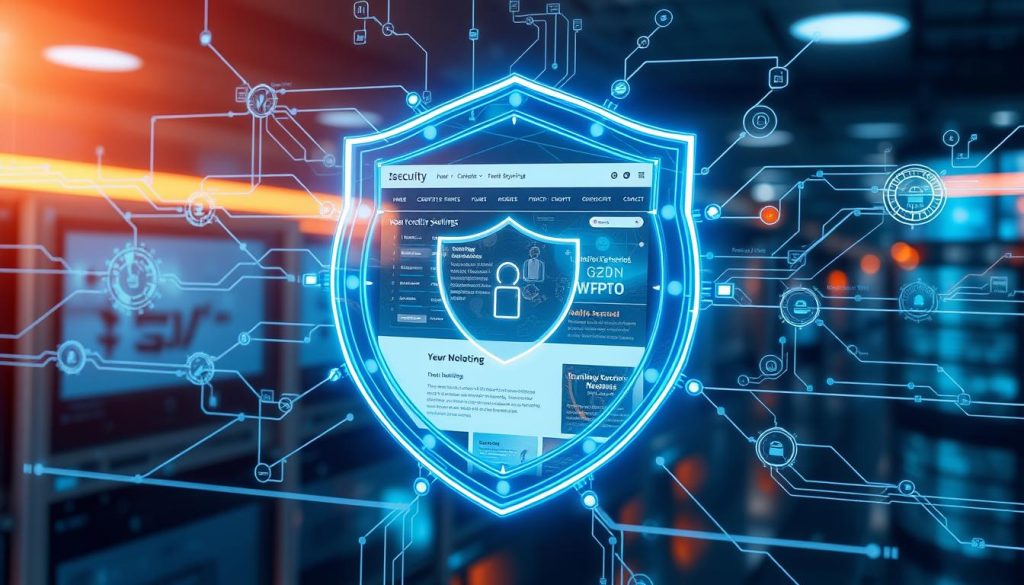
A web application firewall (WAF) is a key security tool for websites. It offers many protective features to fight off cyber threats. Knowing how WAFs work can help webmasters keep their sites safe.
Choosing the right WAF is important. It must fit your specific needs for the best protection.
Benefits of a WAF
Using a WAF brings many benefits:
- It stops attacks like SQL injection and cross-site scripting.
- It blocks bad traffic to keep your data safe.
- It gives you better security insights into your site’s traffic.
- It helps meet security rules by protecting user data well.
Choosing the Right WAF for Your Website
When picking a WAF, think about these points:
- Web application firewall features: Look at the features that match your site’s needs.
- Scalability: Pick a WAF that can grow with your business.
- Cost: Check the price to make sure it fits your budget.
- Customer Support: Choose a provider with good customer service.
By carefully looking at these points, you can pick a WAF that keeps your site safe and secure.
Importance of Regular Backups

Keeping your website’s data safe and available is crucial. Backups protect against data loss from hacking, server crashes, or mistakes. With good backup plans, you can quickly get back on track after problems.
Best Practices for Website Backups
Here are some top tips for reliable backups:
- Set a regular schedule for backups, like daily or weekly.
- Make sure to back up all important files, databases, and settings.
- Keep backups in a safe place away from your local area to avoid loss.
Automating Your Backup Process
Automating backups helps avoid mistakes and keeps things consistent. Many tools and plugins make it easy to schedule backups. This saves time and keeps your website up to date, highlighting the importance of backups.
Community Support and Resources

Being part of a web community is a big help for website owners. It’s a place to share tips and advice on keeping websites safe. This way, everyone works together to make the internet safer for all.
Online Forums and Groups
Joining online forums and groups can really help. You can find lots of useful information and get help when you need it. Here are some great places to start:
- Reddit’s cybersecurity subreddits, where users share insightful tips and discuss recent threats.
- Specific WordPress support groups, offering targeted advice for users of this popular content management system.
- Facebook groups centred on website security, providing real-time discussions and support from experienced professionals.
Useful Tools and Software for Webmasters
Webmasters have many tools and software to improve website security and performance. Here are some top picks:
- Wordfence, a comprehensive security plugin for WordPress that protects against hacks and malware.
- Sucuri, which provides malware scanning and security hardening services.
- Google Search Console, an essential tool for diagnosing issues related to website security and performance.
Future-Proofing Your Website Against Hacking Attempts
To keep your website safe from hackers, you need a strong plan. This plan should include many security steps. Using layers of protection helps block simple and complex attacks.
Adding things like multi-factor authentication, firewalls, and regular scans helps a lot. These steps make it tough for hackers to get in.
Learning about new security threats is also key. Keeping up with the latest news helps you stay ahead. You can learn by attending webinars, reading books, and talking to other webmasters.
Don’t forget to keep your website’s software up to date. Updating regularly fixes holes in your security. This keeps your site safe from future threats.
